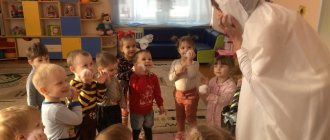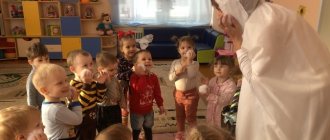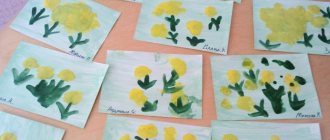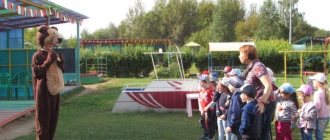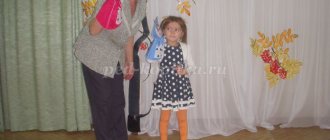Middle group. Junior preschool age. Children 4 - 5 years old
Folklore and physical education lesson for younger preschoolers “Cockerel - Golden Comb” Program content: teach to walk and run with free, coordinated movements of the arms and legs; teach children to grab the bar while climbing; develop dexterity in outdoor play. Materials and equipment: toy cockerel, 2 boards, step ladder, hat-mask...
Summary of a story-based physical education lesson in a middle group based on the fairy tale “Kolobok” Synopsis of a story-based physical education lesson in a middle group based on the fairy tale “Kolobok”
Program content: exercise children in walking while completing tasks at the command of the teacher; exercise balance while walking on a gymnastic bench; develop children's flexibility...
Summary of a lesson on physical development in the middle group using cards-schemes
Summary of GCD
In physical education in the middle group
Target:
Development of the motor system of children.
Tasks:
Educational:
to develop in children the ability to independently organize and perform basic types of movements, schematically indicated on special cards (diagrams); exercise children in walking and completing tasks at the teacher’s signal; repeat exercises with the ball; train children to jump on two legs; train children to crawl on their stomachs on a bench; to train children in maintaining stable balance when walking on elevated support; motivate children to be physically active through the use of non-traditional equipment.
Educational:
develop visual and auditory attention; develop agility and endurance; develop coordination of movements; develop in children the ability to predict their actions, to demonstrate persistence aimed at achieving their goals; develop initiative in each child, the desire to complete the task as best as possible.
Educators:
instill in children a caring attitude towards their health; instill in children a desire to engage in physical education.
Equipment:
tambourine; ball basket; balls (according to the number of children); short jump rope; gymnastics board; mat; gymnastic bench; hoops (6 pieces); cards-schemes with ATS (A4 format).
Progress of the lesson
1 introductory part.
Walking in a column one at a time. Walking and running after the teacher while completing tasks.
At the teacher’s signal: “Horses!” - children walk, raising their knees high, hands on the belt (average pace), transition to normal walking. On the signal: “Mice!” walking on toes, hands behind head. Walking and running in all directions.
Breathing exercises “Ball”
Walking in a column, one after another, children raise their hands up and inhale through their noses. They exhale, lower their hands down, bend over and say “ball.”
(3-4 rubles)
2 main part.
(Children, at the teacher’s signal, line up in two lines)
A) General developmental exercises
with
a ball.
1. I. p. - stand with your feet as wide as your feet, ball down. Rising on your toes, the ball up; return to the starting position (5-6 times).
2. I. p. - stand with feet shoulder-width apart, ball down. Ball up; tilt to the right (left), straighten up, return to the starting position (6 times).
3. I. p. - stand with your feet as wide as your feet, holding the ball in bent arms near your chest. Sit down, bring the ball forward, arms straight; rise, return to the starting position (5-6 times).
4. I.P. – feet together, ball down. Jump legs apart, ball up; return to the starting position (5-6 times).
5. I. p. - lying on your back, legs straight, ball behind your head. Raise your right (left) straight leg, touch the ball to your knee, lower your leg; return to the starting position (6 times).
Abstract of the educational field "Physical Education" in the middle group according to the Federal State Educational Standard
Abstract of the educational field "Physical Education" in accordance with the Federal State Educational Standard in the middle group
Author: Svetlana Evgenievna Sherstneva Place of work: teacher, physical education instructor MBDOU MO Plavsky district “Kindergarten “Smile” Gorbachevo village, Tula region
Physical education lesson using health-saving technologies in the middle group “Merry Journey”.
Goal: Development of physical qualities and strengthening the health of children. To promote the formation of the foundations of a healthy lifestyle and the need to engage in physical education. Give children the joy of participating in the “hike”. Program content • Teach children to walk on a bench using the up-and-down method. • Improve children's walking and running in a column one at a time. • Strengthen children’s skills in walking on their toes, on their heels, with a mincing step, “bear-like” - with support on their palms and feet • Strengthen jumping on two legs moving forward, as well as the ability to crawl under a cord. • Strengthen skills in overcoming obstacles • Develop the ability to act on a signal and follow the rules during outdoor play. • Develop children's dexterity, attention, and speed of reaction. • Promote the health of children’s bodies by using massage techniques with fir cones in the lesson. • Arouse an emotional response in children and a desire to participate in the lesson. • Cultivate kindness, responsiveness, and a desire to help others. Form of organization of classes : travel Methods of teaching used: practical, verbal, visual Equipment and materials: • Laptop, amplification speakers, sound recordings for exercises. • Backpack with fir cones for a group of children • For internal affairs departments: gymnastic beam, 4 hoops, stands with a rope at a height of 50 cm, module for stepping, bench. • For outdoor play: steering wheel circles according to the number of children, a “Pedestrian crossing” sign, red and green circles – traffic light signals. Progress of the lesson Children with a teacher enter the gym and line up. They are met by an instructor with a backpack on his back. Instructor Hello guys, you're in luck! Another minute and you wouldn't have caught me. Educator Why is this? Instructor The thing is, I'm going on a trip. I've already put on my backpack. Educator What about physical education? Instructor Don't worry, we'll figure something out now. Maybe I should take you with me? Guys, are you ready to become little tourists and go on a journey with me? Who do you think tourists are? These are the people who go hiking on foot, on skis, on bicycles, on kayaks and rafts, go down into dark caves, and climb high into the mountains.
Then let's not waste a minute.
Right! Let's turn on the music.
Normal walking, walking on the toes, hands on the belt, straight gallop - “Horses”, walking on the heels of the hands behind the back, mincing step - “Mice”, “Bear”, running, breathing exercise “Soap Bubbles”, normal walking.
Rebuilding in two columns. Instructor So we came to the forest edge. The sun is shining and invites us to play. General developmental exercises Warm-up “Radiant Sun”. Formation into a circle. Instructor: Oh, tired! Let's rest a little and continue our journey. Why do you think a tourist needs a backpack? They put in it things that might be useful during the hike. What would you take with you on a hike? And I put it in the backpack... ask the child to put his hand in the backpack and guess what’s in it. You guessed right. I took fir cones on the hike. These magical cones will help us relieve fatigue. Take them quickly and sit cross-legged in a circle. Game "Wonderful cone" . Goal: to develop fine motor skills of the hands; to develop expressiveness skills and flexibility in movement. The bear walked through the forest, (Fingers walk on his knees) He found a lot of pine cones, (Fists and palms strikes alternately) He found a lot of cones, (Fists and palms strikes alternately) He brought us to kindergarten.
(Punches with fists and palms alternately) One, two, three, four, five! (Bend the fingers on both hands) Let's play with the bump! (Clap) Let's play with the pine cone, (Rolling the pine cone between the palms) Roll between the arms! Let's take our right hand (Strongly squeeze the lump in our right hand) And squeeze it harder! We quickly unclench our hand, (Rolling the pine cone between our palms) Let's roll it on our palms. Let’s take the left hand in our hand (Strongly squeeze the pine cone in our left hand) And squeeze it even harder! We quickly unclench our hand, (Rolling the pine cone between our palms) Let's roll it on our palms. We've finished skating, (Put the pine cone on the floor) Let's count our fingers! One two three four five! (We bend the fingers on the right hand) On the other hand we count, We quickly bend the fingers. One two three four five! (Bend the fingers on the left hand) 1, 2, 3, 4, 5! (We connect the fingers of both hands one by one. We’ve finished playing. We haven’t lost any fingers, (We clap our hands for every word) We played a lot of fun! One, two, three, four, five - It’s time to go, friends, again!
Basic types of movements. Instructor Are you rested? No more tired. We put the pine cones in our backpack. We continue our journey. Ahead of us are a narrow bridge over a stream, a swamp, a windbreak, hills and slopes. Passing an obstacle course using the flow method 1. “Narrow bridge” - walking sideways with an additional step on a gymnastic log, arms to the sides. 2. “From hummock to hummock” - jumping on two legs from hoop to hoop, moving forward. 3. “Windfall” - crawl under a cord 50 cm high, without touching the floor with your hands, step over the module, raising your legs high 4. “Hills and descents” - climb up and down from the bench to the right and left alternately, repeat 3-4 times.
Instructor Guys, we overcame the hills, moved through the swamp, jumping over hummocks, made our way through a windfall, and crossed a narrow bridge over a stream. You can travel not only on foot, you can also travel by (what?)……car. I propose to continue our journey on a miracle car. What do you think is the most important thing about a car? And I think it's the steering wheel. Take the “steering wheels” and quickly come here to the parking lot. And when the driver presses the brake? (When the traffic light is red and when you see the “Pedestrian Crossing” sign, slow down, people may be crossing the road at this point). We follow traffic rules. Be careful! Let's start the engines! Go! Outdoor game “Cars” During the trip, the teacher shows a sign with a “Pedestrian crossing” sign several times. The rear right tire is flat. Is it possible to go like this? No, you need to inflate the wheel with a pump. Let's pump up the wheel. Breathing exercise “Pump”. 1. Bring your hands together in front of your chest, clenching your fists. 2. Bend forward and down and with each springy tilt take gusty breaths, as sharp and noisy as when inflating tires with a pump (5-7 springy bends and breaths). 3. Exhalation is voluntary. Repeat 3-6 times. Note: When inhaling, strain all the muscles of the nasopharynx. We arrived at the railway station. In a few minutes the train will leave the platform. Shouldn't we continue our journey by train? Put down the “rudders” (train whistle) and quickly take your seats in the carriages (children line up one after another). Exercise “Train” Guys, you like traveling by train. And I like it. You look out the window, and everything changes there! Oh, I can see the forest through my window. Pines, spruces, what beautiful nature we have in Russia! What's in this window? Look, there is a river, fishermen are fishing. What do you see in your windows? We drive through big cities and multi-storey buildings. Wow, we're driving along Shkolnaya Street. Can't be! Friends, I see our kindergarten “Smile”. Wow! We drove and drove and arrived at the kindergarten. Get out of the cars. Reflection. So, my little tourists, did you like our trip? How did we travel today? What did you like the most? Will you invite your parents on a trip? You were brave and resilient tourists. Well done. Let's say goodbye. Goodbye.
We recommend watching:
Notes on physical education for children in the middle group. Notes on physical education in the middle group on the topic: Jumping. Notes on physical education in the middle group on the topic: Winter. Notes on physical education for children in the middle group based on the fairy tale Kolobok.
Similar articles:
Summary of physical education classes in the middle group of kindergarten
Abstract of educational activities in the educational field: physical development in the middle group on the topic “To the aid of Dunno”
Funny balls
Physical education lesson for middle group children together with parents.
Goal
: Enriching the joint motor experience of children and parents.
Training tasks
: teach outdoor games with a ball.
Developmental tasks
: develop motor skills and abilities, visual and auditory attention, speed, dexterity and accuracy of movements, their coordination, eye, orientation in space; to form voluntary behavior and the ability to interact in pairs.
Educational tasks
: to cultivate a desire to engage in physical education and the desire to improve one’s motor qualities.
Equipment
: “puddles” made of fabric, “traffic lights”, soft “boards” 2 m x 0.2 m made of polyethylene foam, a bag for balls, a music center.
Handout
: hoops, balls with a diameter of 20-25 cm according to the number of child-parent pairs.
Progress of the lesson
(To the music Yu. Lyzhina “Junior March” parents with children enter the hall
.)
Instructor
: Hello, guys and dear parents! Today you and I will exercise together and improve our health. This will help us...
Round and smooth, He gallops very deftly. Mischievous, cheerful! Of course this is... ( ball
). (
The teacher throws the ball into the hall from behind the door
.)
Instructor
: Our guest, a funny ball, can jump, roll, fly high and hit the target. Today we will perform all movements and exercises with a ball. But how can this be? There is one ball, but there are many of you.
Educator
: Let's go on a journey and find the rest of the balls!
( To the music of V. Solovyov “It’s time to hit the road,” children and parents walk around the hall, holding hands
.)
Instructor
: We walk in step together, And raise our knees.
The sun is shining on the path, We stretch our palms towards it. ( Children and parents walk, raising their knees high, then an adult, walking behind the child, pulls him up by his palms
.)
There are puddles on the road like that, Hey, don’t get your feet wet!
Traffic lights ahead - Don't hit them, and go around! ( Children and parents walk holding hands and step over the “puddles”, and then pass like a snake between the “traffic lights” standing in a row
.)
Who can jump deftly? Who will show everyone his skill? ( Children and parents perform jumps on two legs over soft “boards”.
)
Educator
: To find the balls as quickly as possible, next we will go on a train.
( Parents stand in front of their children and stretch out their hands back. The children cling to them, and to the music of E. Zheleznov “Locomotive” they all move around the hall. The instructor quietly brings in a bag of balls
.)
Educator
: Look, our balls have been found!
( The teacher pours the balls out of the bag. To the music of Sh. Kalosh “In Every Little Child,” children take the balls and run up to their parents, after which adults and children walk in pairs through the middle of the hall
.)
Instructor
: Now it’s time to do exercises with balls together.
( Children and parents perform a set of exercises with a ball in pairs to the song “On a Round Planet” by S. Vasilyev, M. Landa
.)
Stretch on your toes, and quickly touch the ball! ( I.p.: an adult with a ball in his hands and a child stand at a short distance opposite each other, legs together. 1 – the adult raises the ball up, the child stands on his toes and tries to touch the ball with his hands; 2 – i.p. 5 times
.)
Like nesting dolls, they bent over and immediately straightened up again. ( I.p.: an adult and a child hold a ball together in front of them, legs apart. 1 - bend to the right at the same time; 2 - i.p. The same, to the left. 3 times in each direction
.)
Ball to the right, ball to the left, We passed it skillfully. ( I.p.: standing with their backs to each other, legs apart, the adult has the ball. 1 – the adult and the child simultaneously turn to each other, the adult passes the ball to the child; 2 – the same, in the other direction, the child passes the ball to the adult. 6 once
.)
Bend over, pass the ball, don’t let it out of your hands! ( I.p.: standing at a short distance with their backs to each other, legs wider than shoulders, the adult has the ball. 1 – adult and child bend down at the same time, the adult passes the ball to the child between his legs; 2 – i.p.; 3 – child passes ball to an adult in the same way; 4 – IP 6 times
.)
Can you hold the ball? High! We jump with him easily. ( Children jump with balls between their knees to the music, then give them to adults, and they jump in the same way. 4 times 10 jumps. Then everyone performs an exercise to restore breathing
.)
Instructor
: Funny balls will help everyone become dexterous and accurate!
Exercise “Ball to each other”
Children and parents sit on the floor facing each other at a distance of 2.5 m and roll the ball to each other.
Exercise “Straight through the hoop”
Parents with hoops in their hands stand opposite the children at a distance of 2 m. At a signal, the children throw the ball, trying to hit the hoop, and return to their place. The exercise is repeated 6 times, then parents and children change places.
Instructor
: Now we will leave only one fastball.
This is our fast ball, Look how it bounces! ( Children stand on the line, the instructor is opposite them. While hitting the ball, the teacher steps forward. The game is played to the music of Crazy Frog “Popcorn.”)
Girls and boys, jumping like balls!
( Children and adults jump on the spot
.) Now don’t yawn, run away from the ball!
( The children run away and the ball flies after them
.)
Instructor
: Now let's see if the parents can dodge the ball just as deftly.
( To the music of San Diego “La Cucaracha”, two parents sit opposite each other and take turns throwing the ball at the rest of the players between them, who try to dodge. The players who were hit by the ball leave the game
.)
Educator
: But will parents and children be able to run away from the ball while holding hands?
Let's play the game Friendly Couples! ( Parents and children stand in pairs, holding hands. The “Tyrolean song” sounds. The teacher throws the ball at the players, they run away. It is important not to unclasp your hands and dodge the ball
.)
Instructor
: We became friends with the ball, now we don’t care about illness!
Let the balls rest a little, and we will wait for a new meeting with them. ( The instructor conducts an exercise to restore breathing
.)
Instructor
: Be healthy!
Goodbye! ( Parents with children walk through the hall to the march of Z. Petrova and Y. Chichkov “Physical culture-hurray!”
.)
Elena Balandina, physical education instructor,
Secondary School No. 16 SPDS “Little Red Riding Hood”, Zhigulevsk
Construct for physical education classes in the middle group (4-5 years old)
GAPOU SO "Kamensk-Ural Pedagogical College"
Industrial practice construct PM.01 Organization of events aimed at strengthening
child's health and physical development
students of group 23A, Elizaveta Artemovna Novikova
specialty 44.02.01 “Preschool education”
DOO:
MDOU No. 9
Children's age:
senior group (5-6 years old)
Educators:
Shmidt Marina Aleksandrovna, Voinkova Irina Valerievna
Head of practice:
Artemikhina Ksenia Sergeevna
Educational areas:
"Physical development"
Form of organization of sports and recreational activities:
physical education lesson
Kind of activity:
motor
Forms of organization of activities:
group
Target:
To develop children's interest in a healthy lifestyle, physical education and sports.
Planned result:
| Objectives of physical education classes | Tasks taking into account the characteristics of the group’s students |
| Educational tasks: •instill in children the desire to participate in games with elements of competition, relay races; •to foster in children an interest in physical exercise and the need for physical activity. Developmental tasks: •develop physical qualities in children: general endurance, speed, strength, coordination, flexibility. Training tasks: •learn to climb through a hoop straight and backwards; •learn to jump on two legs moving forward over a gymnastic stick; •learn to throw and catch the ball with both hands; •learn to jump on two legs, moving sideways, over a gymnastic stick; •learn to climb through a hoop sideways. Wellness tasks: •continue to form correct posture; the ability to consciously perform movements. |
List of used literature:
1. Federal state educational standard for preschool education. Order of the Ministry of Education and Science of the Russian Federation dated October 17, 2013 N 1155 2.
2. Resolution of the Chief State Sanitary Doctor of the Russian Federation dated May 15, 2013 N 26 “On approval of SanPiN 2.4.1.3049-13 “Sanitary and epidemiological requirements for the design, maintenance and organization of the operating mode of preschool educational organizations”
3. From birth to school: Approximate basic general education program for preschool education / ed. NOT. Veraksy, T.S. Komarova, M.A. Vasilyeva. – M.: MOSAIKA-SYNTHESIS, 2014. – 304 p.
4. Penzulaeva L.I. Physical education in kindergarten: senior group. - M.: MOSAIC-SYNTHESIS, 2014.-128 p.
Principles of preschool education (FSES):
•Full experience by the child of the childhood stage (preschool age), enrichment (amplification) of child development;
•Building educational activities based on the individual characteristics of each child, in which the child himself becomes active in choosing the content of his education, becomes a subject of education (hereinafter referred to as individualization of preschool education);
Summary of an hour of physical activity with elements of sports in the middle group
Bibliographic description:
Tarasova, T. L. Summary of an hour of physical activity with elements of sports in the middle group / T. L. Tarasova, M. Yu. Trufanova, E. S. Shevtsova. — Text: direct // Questions of preschool pedagogy. - 2022. - No. 10 (27). — P. 104-106. — URL: https://moluch.ru/th/1/archive/145/4658/ (access date: 02/05/2022).
Goal: to instill interest in sports games and game exercises with a ball.
educational : to form elementary actions with the ball for football and basketball: throwing, throwing, rolling;
developing: develop coordination abilities, dexterity, eye;
educational: to cultivate interest in activities with the ball;
recreational: involve children in sports.
Equipment : balls according to the number of children, one ball with eyes and a mouth, basketball, football, tennis balls, hoops, goals.
1. Organizational and orientation stage
Educator. Hello guys! I am very glad to see you healthy and cheerful. I really want you to remain in this mood until the end of our lesson.
If everyone smiles -
Good morning will begin.
- Good morning!
2. Motivational and orientation stage.
Educator. Guys, today a guest came to our lesson, and you will find out who this guest is if you guess the riddle:
It can be basketball
Volleyball and football.
Jumps, jumps, flies
And he doesn’t know fatigue.
(Ball)
- That's right, it's a ball.
The teacher shows the ball (pasted eyes, “sad” mouth).
3. Search stage.
Educator. Look guys, our ball is sad.
- Why do you think he is sad?
Children. The ball is sad that they are not playing with it.
Educator. How can we help the ball become cheerful?
Children. Play with him.
Educator. What games can you play with a ball?
Children. Toss, catch, roll, etc.
Educator. What sports games are played with a ball?
Children. Football, volleyball, basketball, etc.
The teacher shows soccer and basketball balls.
— Guys, do you know what sports games these balls are needed for?
Children. For football and basketball. (Show balls)
Educator. Tell a poem about a soccer ball.
Child. The boys play it in the yard.
The kids are lucky to score goals.
You can only kick the ball with your foot.
And only the goalkeeper can touch it with his hand.
Educator. Tell a poem about a basketball.
Child. To become such an athlete, you need to grow up a lot.
And be able to move the ball across the floor without stopping.
To then throw it far and high
And get into the basket, earning a point.
Educator. Guys, what sports games do you think we will play today?
Children. Football and basketball. (plan - put pictures on an easel, sports games football, basketball).
4. Practical stage.
Educator. Today we will play sports games with a ball, but first we need to warm up.
Walking and running one after another, walking with high knees.
Game exercise “The guys have strict order.” Children stand in a column one at a time. At the signal, they scatter across the site. Saying the words “The guys have a strict order, they know all their places, well, trumpet more cheerfully: tra-ta-ta, tra-ta-ta!” With the last words, the children run and take their places.
Educator. Our funny ball
He can't lie like that.
He asks the kids
Play with him some more.
— The balls must be inflated and elastic. Let's pump them up before we play with him.
Breathing exercises “Pumps”
I.p. - stand up straight, lower your arms down to the floor, slightly rounding your back, legs slightly narrower than shoulder width, lower your head, do not pull or strain your neck. Take a short, noisy breath. The inhalation should end with the bending. Raise yourself slightly, but do not straighten, and bend again with a short, noisy sigh.
Educator. I invite basketball players to training.
- Game exercise “Catch it, don’t hit it” - children stand scattered around the playground with balls in their hands. At the signal, they catch the balls after throwing them up.
- Game exercise “Pass the potatoes” - children stand in 2 lines, opposite each other, and on command pass the balls from one end of the line to the other.
- Game exercise “Don’t drop it” - children stand in ranks facing each other. At a signal, they throw the balls to each other with both hands from the chest.
Educator. I invite football players to training.
- Game exercise “Ride” - children stand in 2 lines, facing each other. At the signal, the children pass the ball to each other with their feet.
- Game exercise “Ball into the goal”. Children stand in 2 columns and take turns kicking the ball into the goal.
- Game exercise “Don’t lose it” - children stand near the hoop. At the signal, they kick the ball around the hoop.
Independent activity of children.
One subgroup of children throws balls into the hoop, the other scores the ball into a football goal.
Game “Which ball is missing?” The teacher shows 3 balls of different sports (soccer, volleyball, tennis). Children close their eyes, and the teacher hides one of the balls.
5. Reflective-evaluative stage.
Educator. Guys, were we able to please our guest?
— Has the ball become fun? (the ball smiles).
— What sports games did we play?
- Which exercise was the easiest?
— Which exercise was difficult to perform?
—Which exercise was the most fun?
6. Follow-up.
Educator. In the next lesson we will repeat sports games with a ball. We’ll also play with the smallest of sports balls—tennis balls.
Key terms
(automatically generated)
: ball, teacher, game exercise, child, friend, game, What exercise, kick ball, ball, guys.
